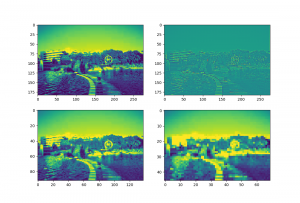推荐学习书目
› Learn Python the Hard Way
Python Sites
› PyPI - Python Package Index
› http://diveintopython.org/toc/index.html
› Pocoo
值得关注的项目
› PyPy
› Celery
› Jinja2
› Read the Docs
› gevent
› pyenv
› virtualenv
› Stackless Python
› Beautiful Soup
› 结巴中文分词
› Green Unicorn
› Sentry
› Shovel
› Pyflakes
› pytest
Python 编程
› pep8 Checker
Styles
› PEP 8
› Google Python Style Guide
› Code Style from The Hitchhiker's Guide
V2EX › Python
tensorflow CNN 卷积神经网络中的卷积层和池化层的代码和效果图
fendouai_com · 2017-07-28 10:39:22 +08:00 · 2393 次点击这是一个创建于 2751 天前的主题,其中的信息可能已经有所发展或是发生改变。
因为很多 demo 都比较复杂,为了让 demo 比较简单,专门抽出这两个函数,写的 demo。
#!/usr/bin/python
# -*- coding: UTF-8 -*-
import matplotlib.pyplot as plt
import tensorflow as tf
from PIL import Image
import numpy
img = Image.open('szu.jpg')
img_ndarray = numpy.asarray(img, dtype='float32')
print(img_ndarray.shape)
img_ndarray=img_ndarray[:,:,0]
plt.figure()
plt.subplot(221)
plt.imshow(img_ndarray)
w=[[-1.0,-1.0,-1.0],
[-1.0,9.0,-1.0],
[-1.0,-1.0,-1.0]]
with tf.Session() as sess:
img_ndarray=tf.reshape(img_ndarray,[1,183,276,1])
w=tf.reshape(w,[3,3,1,1])
img_cov=tf.nn.conv2d(img_ndarray, w, strides=[1, 1, 1, 1], padding='SAME')
image_data=sess.run(img_cov)
print(image_data.shape)
plt.subplot(222)
plt.imshow(image_data[0,:,:,0])
img_pool=tf.nn.max_pool(img_ndarray, ksize=[1, 2, 2, 1], strides=[1, 2, 2, 1],
padding='SAME')
image_data = sess.run(img_pool)
plt.subplot(223)
plt.imshow(image_data[0, :, :, 0])
plt.subplot(224)
img_pool = tf.nn.max_pool(img_ndarray, ksize=[1, 4, 4, 1], strides=[1, 4, 4, 1],
padding='SAME')
image_data = sess.run(img_pool)
plt.imshow(image_data[0, :, :, 0])
plt.show()
卷积和池化效果图:

更多资源教程: http://www.tensorflownews.com
1 条回复 • 2017-07-28 10:56:10 +08:00
1
pming1 2017-07-28 10:56:10 +08:00
不明觉厉
|